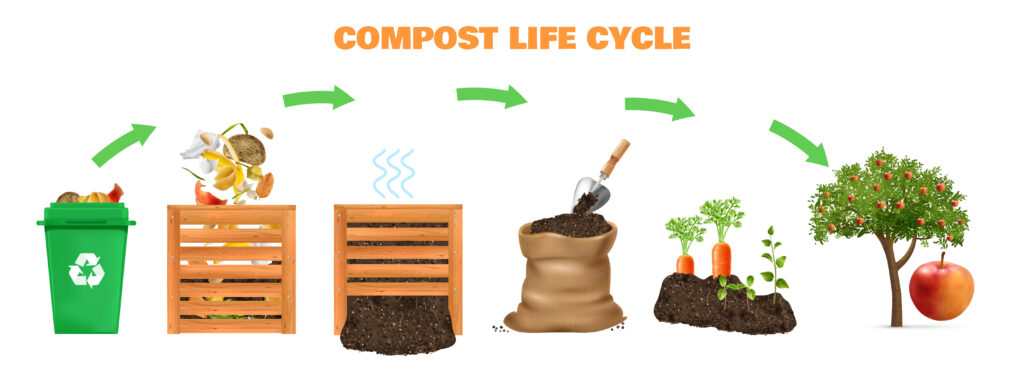
Lately, composting has come up in quite a few conversations – and I will admit, some of the reactions surprised me. It turns out there is still a lot of confusion, hesitation, and even frustration around the idea of separating food waste at home. But instead of feeling discouraged, I am more motivated than ever to help clear things up.
These chats reminded me that while there are real barriers to composting, most of them are easier to overcome than we think. My hope is to offer some clarity, bust a few myths, and inspire more families to take that next small but impactful step toward reducing waste and composting more.
Let’s start by chatting about food waste – what is it exactly?
My initial goal was to put together an easy-to-understand guide to help you make choices that put you in position to be a part of the solution, as well as to feel good about what you are doing as you move forward. I thought the best place to start was by defining food waste and I wanted to use the words, “quite simply food waste is,” but it is not a definition to say in a few simple words, even though in reality, it is quite simple to understand.
So here is my attempt at a definition using probably far too many words but hopefully driving home the meaning so that there are no unanswered questions.
Here goes my best…
- Attempt #1 – Food waste is post-harvest food that never gets eaten, but it can also come from animal products. So, not just “post-harvest food.”
- Attempt #2 – Food waste is any edible food that is uneaten, but it also includes banana peels, eggshells, bones, and the like. So, not just edible food.
- Attempt #3 – Food waste is any food that is prepared for human consumption yet not eaten, but it also includes food lost along the food supply chain – like at the farm, during transportation, or in storage – before it gets to the end consumer.
- Attempt #4 – Food waste is any part of our food system that is intended for human consumption but ends up discarded, uneaten, or unused—whether it’s edible or inedible, lost at any point from farm to fork, or wasted in households, restaurants, stores, or supply chains.
How about some specifics to further clarify!
Are you beginning to understand why I had a difficult time coming up with a short but clarifying definition? “Food” very unfortunately becomes food waste for a variety of reasons. Here are some specific examples to help develop your understanding further.
- Leftover food (Plate waste) – This is food that is leftover on your plate in a restaurant or after a meal at home. The food that gets scraped off the plate and into the trash by you or the staff at a restaurant, or the like.
- Excess food (Overstocking/Overordering) – This represents the prepared food at a school, restaurant, or hotel. Can you picture a buffet, or catered event? If you have ever been on the food preparation side then you know there is always a percentage over the actual food order that is arranged to ensure that there is enough for everyone, but this more often than not ends up in the trash.
- Wishful food – This is the spoiled food that you find in the back of your fridge. Maybe you forgot all about it, maybe you did not feel like cooking and instead got take-out. No judgement here! I know how crazy busy life can be. I also know how painful it is to clean out the fridge and throw all that food away!
- Spoiled food (Food loss)– Depending on where you live, your food may have to travel quite a bit before it shows up on your grocery store shelves. Even if you are close to food sources, your food goes through many steps prior to you picking it up at the store. I live in the Northeast, and a lot of fruits and veggies are picked prior to being ripe so that they ripen on their way to me. But the transportation conditions are not perfect and between the farm or original source, and the grocery store a lot can happen. Food that rots in transport never makes it to the grocery store shelves.
- Ugly food (Cosmetic imperfections)– Who buys the food that you pick up in the produce section and then put back down because it has bruises or marks? The answer a lot of the time, is no one. Have you ever been shopping while the staff are removing all of the unpurchased food before they restock with the fresh new produce? All the produce that is getting thrown in the box – that is food waste.
- Scrap food (Production waste)– This is the food that is wasted when you are peeling your potato or carrot, cutting out the core of an apple or pepper, or chopping off the ends of your onions. Of course, this also applies to trimming meat of its fat or removing bones and even to eggshells. Any food that ends up on your cutting board is included in this category.
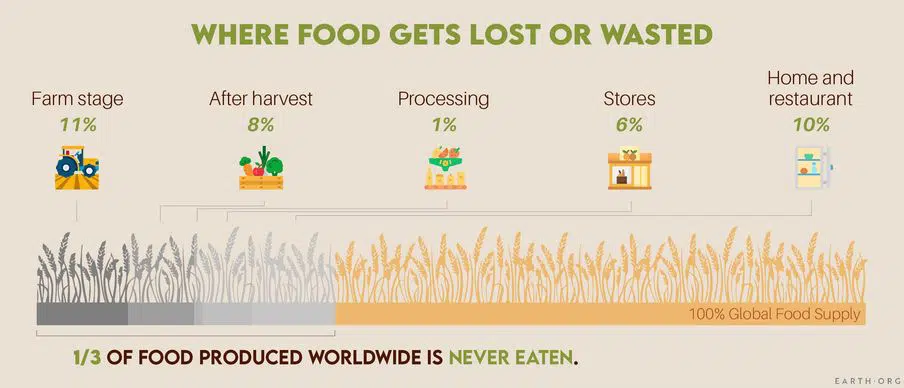
I am not sure that I have covered absolutely every scenario, but I think you get the idea!
Your question now might be, so what’s the big deal?
Again, there is a lot. None of this can be expressed in a few words, so here are the highlights:
- There is a painful irony in the global food system: we produce enough food to feed 10 billion people, yet millions still go hungry every day. For many of us, that hits close to home – we grew up hearing the phrase, “Finish your dinner. There are starving children in Africa.” Ring a bell? I remember thinking (and maybe even boldly saying aloud), “Well, send my plate to Africa then.” I understand now (and even as a kid) of course that it is not that simple. Logistics make it impossible to just ship leftovers across the globe. But what I can do is be far more mindful of what ends up on my plate and what happens to it afterward.
- Outside of the global inequality, the production of food is resource-intensive. We use water for irrigation. While land that could be a natural ecosystem supporting biodiversity is instead used in agriculture. Food production uses energy, fertilizers, and pesticides, never mind the carbon intensive transportation system that carries our food across the country and sometimes across the world.
- Food waste is responsible for roughly one third of anthropogenic greenhouse gas emissions, producing approximately 170 million metric tons of CO2e (carbon dioxide equivalent) which is comparable to emissions from forty-two coal fired power plants. This estimate does not include our food waste that is rotting in landfills across the country producing methane – which is 25% more potent than CO2. If food waste were a country, it would be the third largest emitter in the world.
Why is food waste rotting in landfills instead of biodegrading?
You may be asking, well why doesn’t food just biodegrade in a landfill. Why does it have to be separated from the household trash? The answer is that food waste needs air and sunlight to compost. Without oxygen and sun, organic materials that are buried in landfills rot and emit methane gas. Composting is a process. It is not just about taking your food and dumping it somewhere in your yard or out in nature. If you take a pile of food waste and leave it alone, it will rot. It needs a bit of attention to turn into the nutrient-dense soil that is the result of composting.
And herein lies the problem because this is where it gets a little too nature-intense for some. In order to effectively compost, food waste needs to be mixed together with “browns,” which include dry leaves, wood chips, and even cardboard works. And because compost needs air and sunlight, it needs to be turned. Composting is definitely a project that needs to be managed. Essentially composting is helping with the natural decomposition of your food waste, but it needs a certain environment to do this successfully.
Composting might not be for everyone – and that is totally okay!
Maybe you do not have the time (or the stomach) to be out in the yard turning piles of food scraps, or perhaps you do not have outdoor space for a compost bin or vegetable garden. No judgment – really! The good news is you can still be part of the solution.
Many towns now offer separate bins or drop-off programs for food waste. If yours does not, it might be time to ask your local officials to consider it or look into nearby businesses that offer composting services. Here is the link to a local company in Connecticut that offers residential and commercial food waste pick-up services. https://www.blueearthcompost.com/ I know it will not work for everyone depending on where you live, but at least it may offer you a reference point to the kinds of services that might be available near you.
At my house, we use a Mill Food Recycler, and I absolutely LOVE it. It takes all our food waste and transforms it into dry, nutrient-rich grounds that can be spread directly in the garden, used as chicken feed, or send it back to the company to be used. It is a clean, convenient option if traditional composting is not realistic for you. If you are curious, you can check it out here: https://mill.pxf.io/K0JYaA
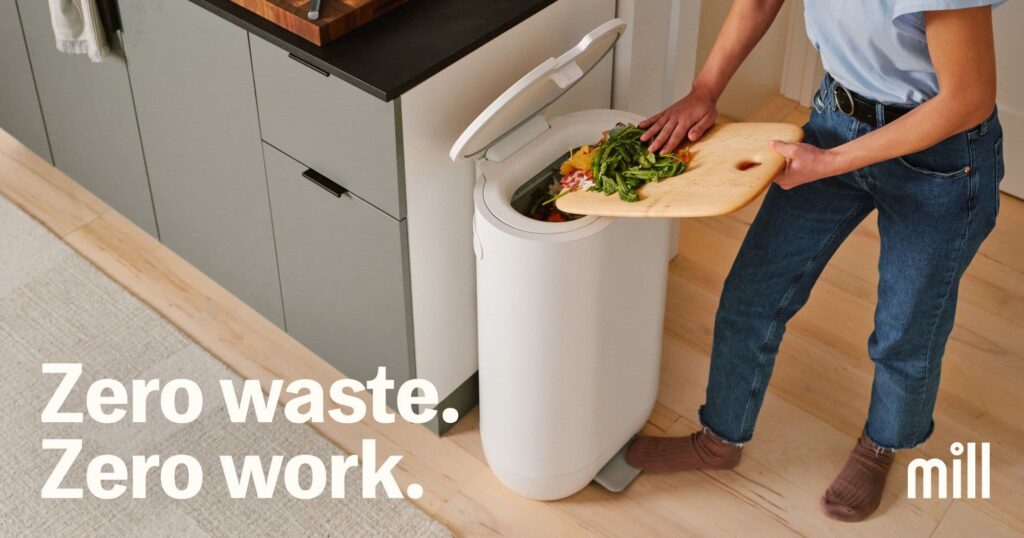
OMG, that’s a lot!
There is no doubt about it, keeping food waste out of landfills is critical. While this post just scratches the surface of such a massive and complex issue, I always want to leave you with practical steps you can take right now to make a difference. Small changes, when multiplied by many, can have a big impact. Below are a few simple ways for you to get started.
Action Steps to Tackle Food Waste at Home:
- Start with your grocery list. Thoughtful meal planning helps you buy only what you need – and actually use it. Need ideas? Check out my post on envelope budgeting and smarter shopping: https://www.thecarbonemissionsproject.com/envelope-budgeting-diminish-food-waste-eliminate-packaging/
- Rethink restaurant portions. Oversized meals often lead to waste. My daughter and I made a pact to share dishes when dining out – it saves money and food!
- Save your veggie scraps. Turn food prep leftovers into homemade vegetable broth. It is simple, satisfying, and waste-reducing. Here’s my go-to recipe: https://www.thecarbonemissionsproject.com/vegetable-stock-recipe/
- Donate what you can. If you have extra, check in with your local food pantry to see what is needed and what is accepted. With a little planning, your surplus food could nourish someone else instead of ending up in the trash (or compost bin).
- Find a food waste solution that works for your home. Whether it is backyard composting, curbside pickup, or a food recycler like Mill, the goal is simple: keep food waste out of your household garbage.
Remember: Progress over perfection. You don’t have to do everything – just something. What is one food-saving habit you can commit to this week? Share your thoughts in the comments below!
A post blog note …
I just wanted to share pictures from Denmark. Every home and business separates its food waste. I know these items are in Danish, but they show the separate bags for trash and food waste. The bins are all the items that are separated into different sections of the recycling bin. I hope that seeing a solution from across the world may inspire you!
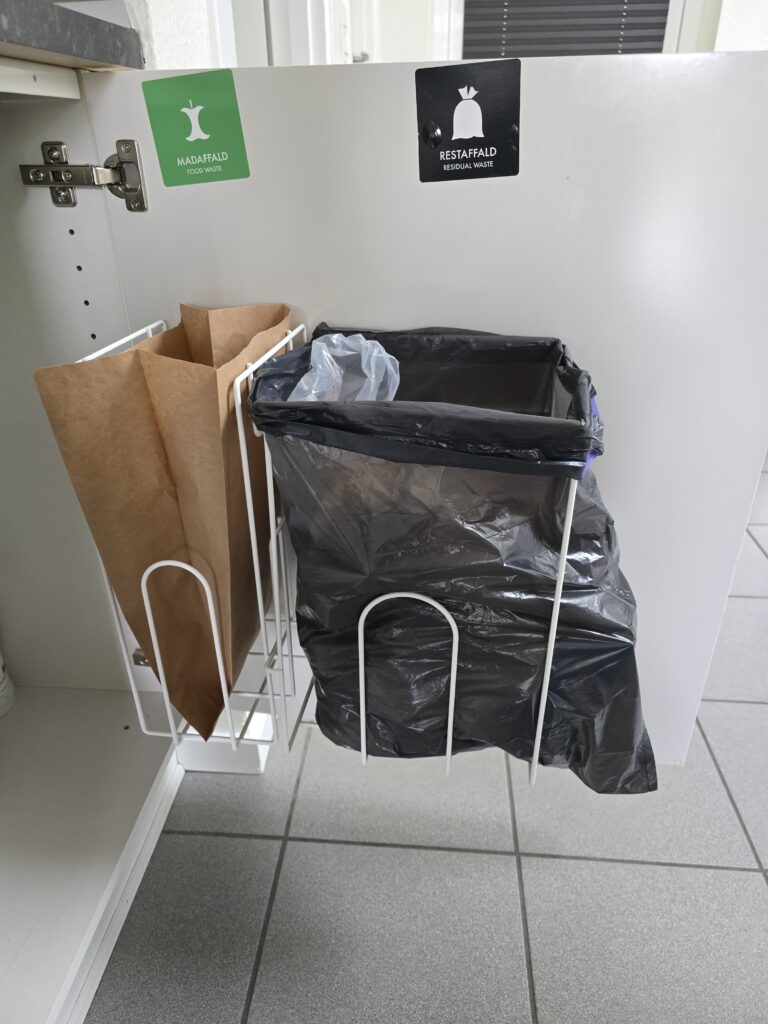
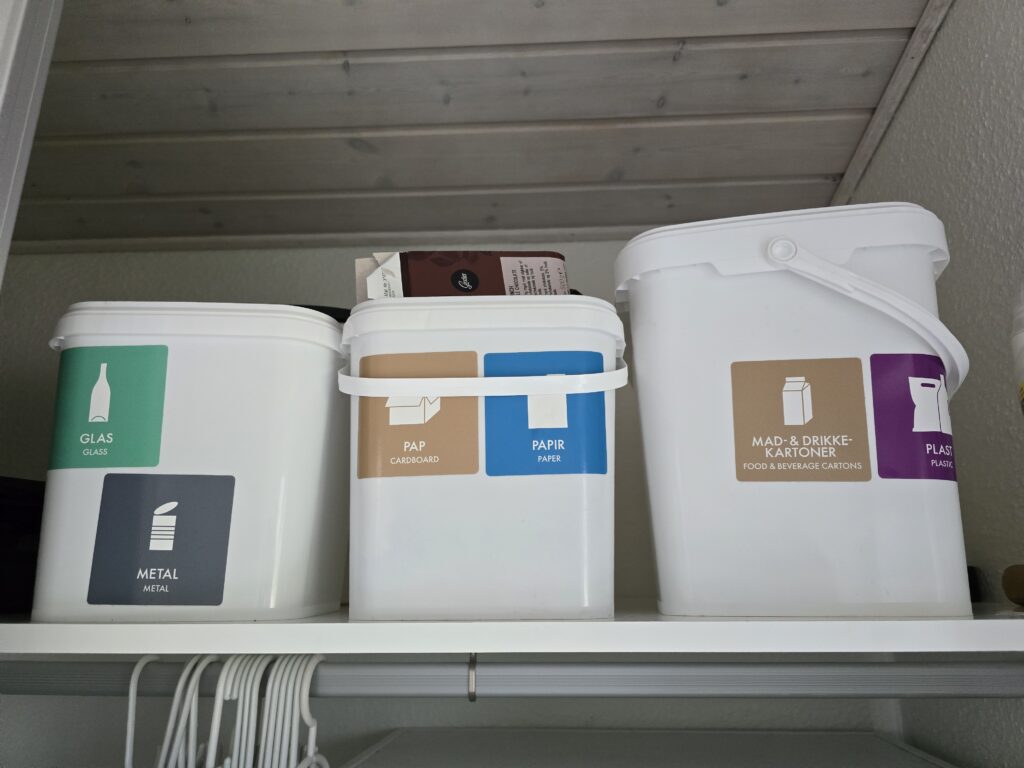
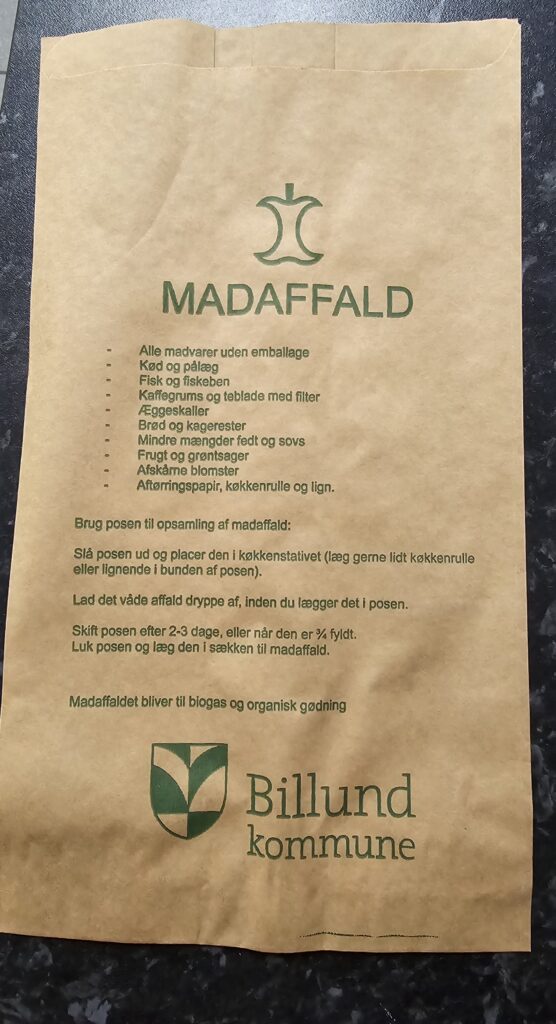
References:
Food Waste FAQs. (2025, June 13). Home. https://www.usda.gov/about-food/food-safety/food-loss-and-waste/food-waste-faqs
Composting at home | US EPA. (2025, April 15). US EPA. https://www.epa.gov/recycle/composting-home#:~:text=Additional%20Resources-,What%20is%20Composting?,tree%20trimmings%2C%20and%20food%20scraps.
World Food Program USA. (2024, November 26). Here are 10 facts on hunger and WFP’s work. https://www.wfpusa.org
Lai, O. (2023, September 26). ExPLaiNer: What is food waste? www.Earth.Org
Sustainability Pathways: Food loss and waste. (n.d.). http://www.fao.org/nr/sustainability/food-loss-and-waste
Lewis, J. (2024, March 4). How does food waste affect the environment? Earth.Org. https://earth.org/how-does-food-waste-affect-the-environment/
Food Waste and its Links to Greenhouse Gases and Climate Change. (2025, June 16). Home. https://www.usda.gov/about-usda/news/blog/food-waste-and-its-links-greenhouse-gases-and-climate-change

Leave a Reply